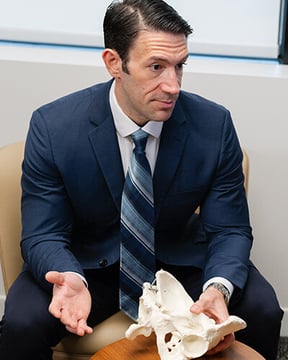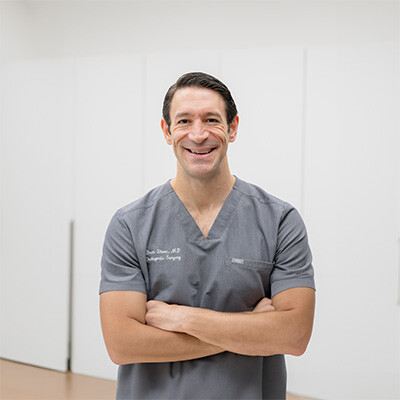Hip Arthroscopy Overview:
Hip preservation is my passion, which is why a large portion of my practice is dedicated to it and many of the procedures I perform are considered hip arthroscopy surgeries. An arthroscopic hip surgery is a minimally invasive surgical procedure used to diagnose and treat various conditions affecting the hip joint. It involves inserting a small camera, called an arthroscope, into the hip joint through tiny incisions. This allows the surgeon to visualize the interior of the hip joint and perform surgical interventions to address abnormalities, such as tears in the labrum, cartilage damage, impingement of the hip joint, or various hip injuries.
Video: Meet Dr. Brett Shore, Orthopedic Hip Expert

Symptoms That May Require Hip Arthroscopy Surgery:
- Hip Pain: Patients with hip joint abnormalities may experience chronic or intermittent pain in the hip region. This pain may be sharp, stabbing, or dull, and can be exacerbated by activity, movement, or prolonged sitting or standing.
- Groin Pain: Pain may be felt in the groin area, particularly with certain movements such as hip flexion or rotation.
- Snapping Hip or Catching Sensation: Some patients may experience a clicking or catching sensation in the hip joint, especially during movement. This symptom is called ‘snapping hip’ and is a good indicator a patient may need an arthroscopic hip procedure.
- Limited Range of Motion: Hip joint abnormalities can lead to a decreased range of motion in the hip joint, making it difficult to perform certain activities such as squatting, bending, or lifting.

Hip Arthroscopy Surgery Treatments:
There are many different types of hip arthroscopies, depending on the true cause of the patients’ pain. Many of these procedures can be performed using minimally-invasive techniques, or through traditional open surgery, depending on the severity of the symptoms and diagnosis.- Diagnostic arthroscopy: In some cases, hip arthroscopy may be performed as a diagnostic procedure to evaluate the hip joint and identify the underlying cause of symptoms. During diagnostic arthroscopy, the surgeon can visualize the structures within the hip joint, such as the labrum, cartilage, and ligaments, to assess for any abnormalities.
- Hip arthroscopy for femoral acetabular impingement: Femoral acetabular impingement is when there is a mismatch in the radius of curvature of the femur (which is a ball) and the acetabulum (which is a socket), leading to abnormal contact between the ball and socket (called an Impingement). The location of the impingement can vary. Hip impingement surgery, by means of arthroscopy, can alleviate these symptoms.
 • Hip arthroscopy for labral hip tear repair: Tears in the labrum, a ring of cartilage that surrounds the hip joint, can be repaired using specialized instruments inserted through small incisions during arthroscopy. Depending on the severity of the tear, it may require a labral reconstruction, which involves using cadaver tissue to craft a new labrum for the patient.
• Hip arthroscopy for labral hip tear repair: Tears in the labrum, a ring of cartilage that surrounds the hip joint, can be repaired using specialized instruments inserted through small incisions during arthroscopy. Depending on the severity of the tear, it may require a labral reconstruction, which involves using cadaver tissue to craft a new labrum for the patient.• Hip arthroscopy for gluteus medius and minimus repair: Hip arthroscopy for gluteus medius and minimus repair typically involves making small incisions around the hip joint and then using an arthroscope to view the hip joint. The surgeon then uses small instruments to secure the torn tendon back to its attachment site, and may embed suture anchors into the bone.
• Hip arthroscopy for Hip Bursitis: This procedure involves removing the bursa, a small, fluid-filled sac that cushions the bones, tendons and muscles near your joints. The bursa is removed without hurting the hip, and the hip can function normally without it. Hip bursitis is a common cause of pain on the outside of the hip, and is usually caused by a tight iliotibial (IT) band running on the outside of the hip, causing friction between it and the bone underneath.
 Hip arthroscopy for partial thickness and full thickness hamstring tears: To repair partial thickness and full thickness hamstring tears, the surgeon may debride (trim away) any damaged tissue and perform a repair if necessary, which could involve techniques like suturing or using anchors to reattach the tendon to the bone. For full thickness tears, the repair may involve more extensive techniques, such as tendon reattachment or augmentation with grafts.
Hip arthroscopy for partial thickness and full thickness hamstring tears: To repair partial thickness and full thickness hamstring tears, the surgeon may debride (trim away) any damaged tissue and perform a repair if necessary, which could involve techniques like suturing or using anchors to reattach the tendon to the bone. For full thickness tears, the repair may involve more extensive techniques, such as tendon reattachment or augmentation with grafts.- Revision hip arthroscopy: As the field of hip arthroscopy has grown, there are more and more surgeons who are performing hip arthroscopy. Since it is a more technically difficult surgery than most of the other arthroscopic procedures that are performed, some of the surgeons do not accomplish all of the goals that one would want to accomplish with the procedure. When patients have remaining residual impingement, recurrent labrum tears, or capsular defects, it may be beneficial to undergo a revision arthroscopy. This gives the patient the best chance of preserving their native hip and continuing on with the activities in life that they enjoy in a relatively pain free manner.
- Debridement: Damaged or degenerated cartilage within the hip joint can be trimmed or removed (debrided) using arthroscopic instruments to alleviate pain and improve joint function.
- Osteoplasty: If there is impingement of the hip joint, where abnormal bony growths restrict movement, the surgeon can use arthroscopic techniques to reshape the bones and restore normal joint mechanics.

Hip Arthroscopy Recovery:
Following hip arthroscopy, patients typically experience some discomfort or swelling around the hip joint. Pain medication and ice packs may be prescribed to manage pain and inflammation.
In the hands of an experienced hip arthroscopy surgeon, almost all forms of hip impingement and labral damage can be treated arthroscopically — instead of patients being hospitalized for several days, be left with a 10-12 inch incision and have restrictions going forward, we’re able to treat the same problems in an outpatient setting that takes 1-2 hours with a much faster recovery time. Patients who receive a hip arthroscopy will be on crutches for a few weeks on average, and usually recover fully by 4-6 months after surgery.
Patients who receive a hip arthroscopy will be on crutches for a few weeks on average, and usually recover fully by 4-6 months after surgery.
Patients are gradually encouraged to resume normal activities, starting with gentle exercises and increasing intensity over time as tolerated. It's essential to follow post-operative instructions provided by your surgeon and physical therapist to prevent complications and promote healing.
Physical therapy also plays a crucial role in the recovery process, helping to improve strength, flexibility, and mobility in the hip joint. A customized rehabilitation program may be designed to address specific deficits and optimize functional outcomes.
Overall, hip arthroscopy offers a minimally invasive approach to diagnose and treat a variety of hip joint abnormalities, allowing patients to achieve pain relief and improved function with minimal disruption to their daily activities. Patients considering hip arthroscopy should consult with a qualified orthopedic surgeon to determine the most appropriate treatment plan based on their individual condition and goals.
Consider scheduling a consultation at DISC, which is a great option for this particular procedure due to our overlap of spine and hip pathology. By working with excellent spine surgeons and pain management specialists, we are able to really determine what it is that is causing patients’ pain to give them the best opportunity for a good outcome and recovery.
ARTICLE CATEGORIES: Patient Education, Orthopedic Care, hip, Hip Arthroscopy

About the author
Brett I. Shore, MD As one of Southern California's few comprehensive hip specialists, Dr. Shore offers individualized care for the entire spectrum of hip conditions, with a treatment philosophy that incorporates both conservative treatment and advanced surgical interventions. Read more articles by Brett I. Shore, MD.





